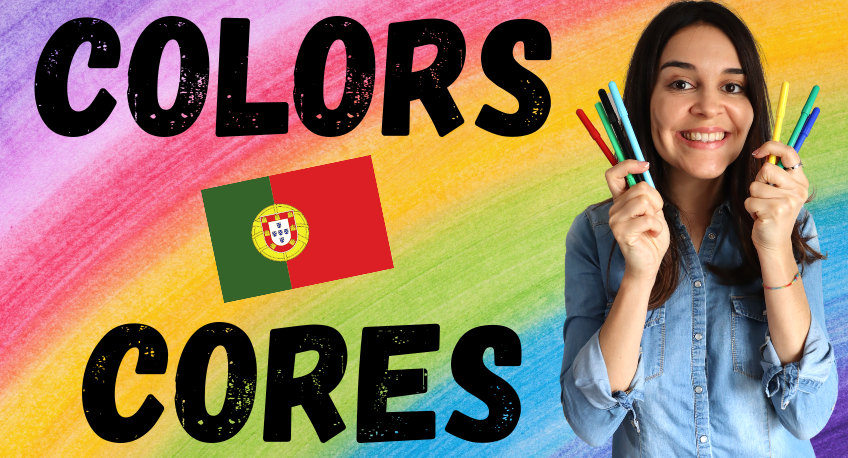Olá everyone! Today i will speak about the colors in European Portuguese.
Let’s go!
You can also watch the following YouTube video about the colors in Portuguese:
If you like the video, feel free to subscribe to my YouTube channel. I post videos like this one, every week on Mondays and Wednesdays.
The Colours In Portuguese
Azul – Blue
Branco – White
Preto – Black
Amarelo – Yellow
Bege – Beige
Cor de laranja ou Laranja – Orange
Cor-de-rosa or Rosa – Pink
Roxo – Purple
Lilás – Lilac
Castanho – Brown
Bordô ou Cor de Vinho – Burgundy
Cinzento ou Cinza – Grey
Prateado – Silver
Dourado – Gold
Vermelho ou Encarnado – Red
Verde – Green
Sentences related to the colors in Portuguese
Qual é a tua cor favorita?
A minha cor favorita é o amarelo.
E a tua?
A minha cor favorita é o azul.
Notice that the word colour in Portuguese is feminine:
A cor
A tua cor favorita
But, the colours themselves are masculine by default.
O amarelo
O azul
A minha cor favorita é o amarelo.
A minha cor favorita é o azul.
Now, let’s see some other examples:
O mar é azul.
A camisola da Maria é azul.
Os comboios são azuis.
As bolas são azuis.
Notice that adjectives that don’t end in an “o” do not change according to gender, but they do change according to number – singular or plural.
Take a look again:
O mar é azul.
A camisola da Maria é azul.
No change!
Os comboios são azuis.
As bolas são azuis.
These change!
The same happens with the other adjectives that do not end in an “o”.
Take a look at another example.
O campo é verde.
A caixa é verde.
Os lápis são verdes.
As limas são verdes.
Ok, now that this is hopefully clearer, let’s check other colours:
O sol é amarelo.
A janela é amarela.
Os vasos são amarelos.
As casas são amarelas.
As you see, colours that end in an “o”, like “amarelo”, will change both according to gender and number. Don’t forget!
Let’s see one more ending in “o”:
O telemóvel é preto.
A moldura é preta.
Os pneus são pretos.
As camisas são pretas.
See? They all changed depending on the gender and number!
But what about those two composed ones? Cor de laranja and cor-de-rosa?
They are also a little bit different, as they don’t change. Ever. 🙂
Let’s take a look:
A laranja é cor de laranja.
As laranjas são cor de laranja.
O biquini é cor de laranja.
Os biquinis são cor de laranja.
No change!
The same with pink:
A saia é cor de rosa.
As saias são cor de rosa.
O chapéu da criança é cor de rosa.
Os chapéus das crianças são cor de rosa.
No change either!
The same happens to Cor de Vinho. So basically, anytime you have Cor de… something, this will not change.
Also, pay attention that with Cor de Laranja or Cor-de-Rosa, you can simplify and simply say “laranja” or “rosa”. Nevertheless, they will not change according to gender or number.
So, now that you know the basic rules, here come some other examples with other colours:
O vestido de noiva é branco.
A minha cadela é bege. Ou é dourada?
A areia é dourada!
A caneta é roxa.
As calças são lilás.
Ah, I almost forgot about this one! Lilás also does not change according to gender or number, since it already ends in an “s”.
So, you will have:
As calças são lilás.
A saia é lilás.
Os calções são lilás.
As paredes são lilás.
I know, it is a little bit different.
But this is the last one. I hope 🙂
Let’s continue with our examples:
O sofá é castanho.
A t-shirt é bordô ou cor de vinho.
UPS, my mistake. Again! Bordô, although it ends in an “o”, theoretically, it will not change according ever. It stays the same:
A t-shirt é bordô.
O saco é bordô.
As malas são bordô.
Os pijamas são bordô.
Now, this was the last one!
Let’s continue with our examples:
O céu está cinzento or O céu está cinza.
O anel é prateado.
Os rubis são vermelhos. or Os rubis são encarnados.
Ufff…we got to the end of the list without further bumps! Well done!
So to sum up:
- Adjectives ending in “o” – change according to gender and number
- Adjectives ending in another letter – change according to number, but not according to gender
- Cor de laranja, Cor-de-Rosa, Lilás and Bordô do not change at all.
And that’s it! You now know the colours in Portuguese. Tell me, what is your favourite colour?
Qual é a tua cor preferida?
Let me know in the comments below.
Also, if you are looking for a structured online course to teach you European Portuguese fast and effectively, make sure to check out my online school, Mia Esmeriz Academy. See you there 🙂
Beijinhos!
Mia

